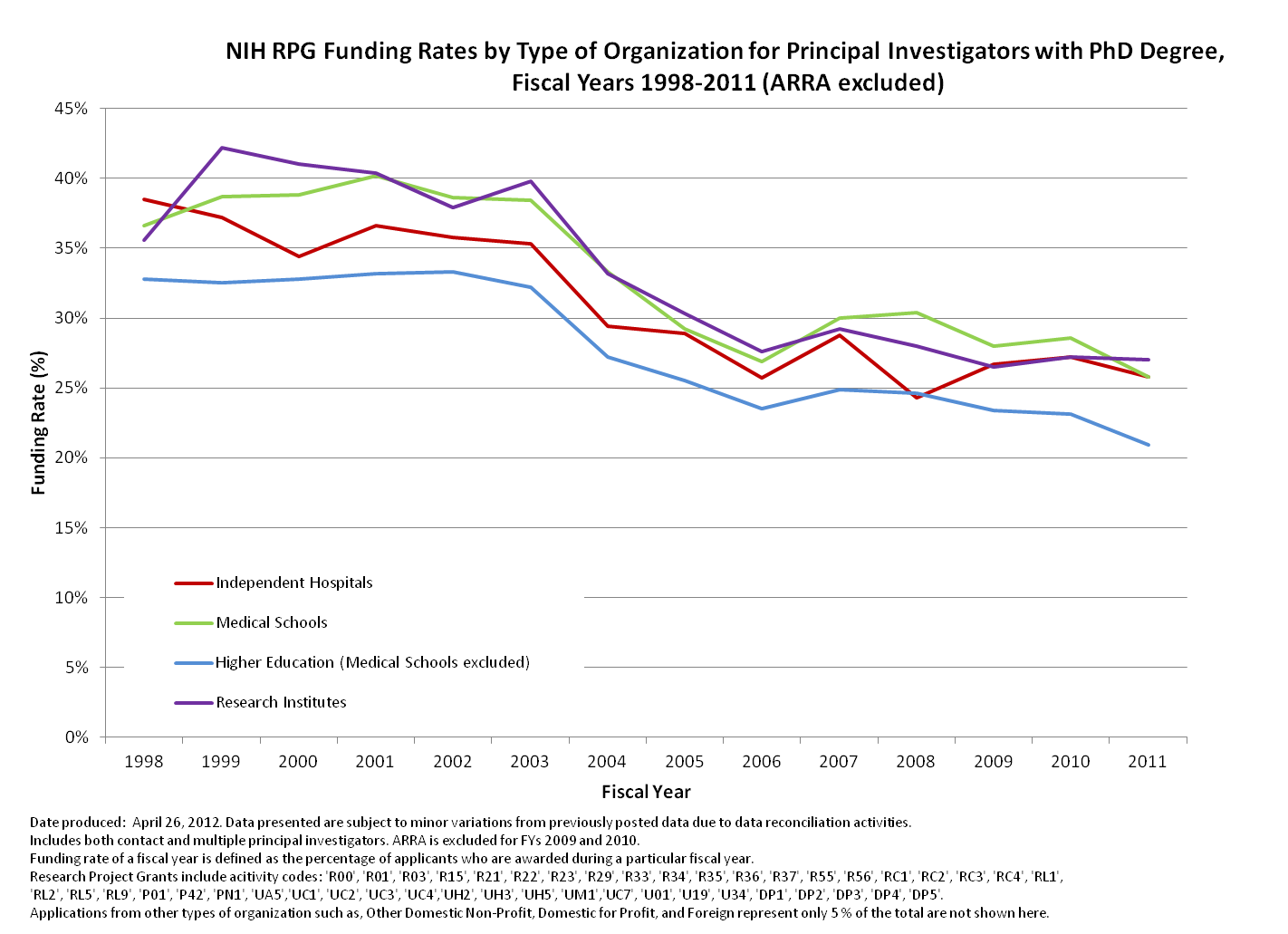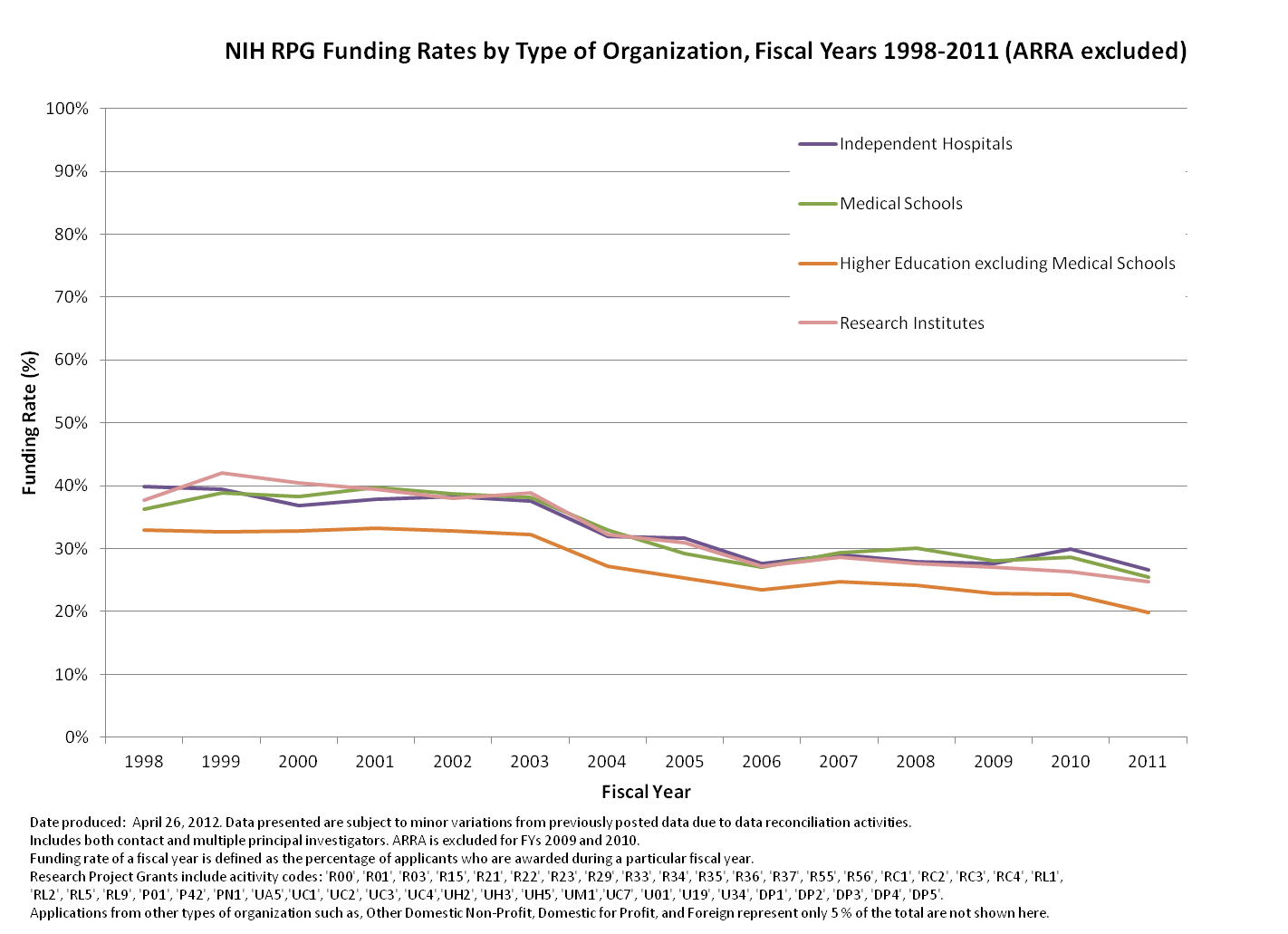8 Comments
A few blogs ago, I provided information about investigators and different institution types. Let’s cut the data a couple additional ways. We’ve seen that investigators with a PhD tend to do slightly less well when competing for NIH funding. When you break out investigators by degree and the type of institution they work at, there isn’t really a big difference that pops out between those with an MD, PhD, or MD/PhD.
What if we compare the funding rate of investigators with a PhD from different institution types to each other? What you see is that investigators with a PhD at medical schools and research institutes fare better (by several percentage points) when compared to investigators with a PhD at institutions of higher education (not including medical schools).
If we look at funding rates broken out by type of organization, all investigators combined, we see a similar pattern. Overall, institutions of higher education (not including medical schools) have a lower funding rate when compared to independent hospitals, medical schools, and research institutes.
In the two graphs, there are differences in funding rates by institution, with higher education institutions having a lower funding rate, and there are differences by degree, with PhDs at a lower rate. Two weeks ago when we looked at rates by degree and institution type, we saw that, in general, PIs had the same funding rates regardless of degree type within each institution type. Medical schools had nearly identical rates for each degree type. So why do PhDs appear to have lower funding rates than other degree types? It is because they are most heavily concentrated in the institution type that fares least well—institutions of higher education (not including medical schools), see table 1 below. Remember, PhDs at medical schools do as well as MDs or MD/PhDs.
While these data are interesting, we have not tried to explain the cause of the differences as many institutional and situational factors contribute to PI funding rates. More food for thought.
| Fiscal Year | Organization | MD | MD/PhD | PhD | Total |
| Applicants(%) | Applicants(%) | Applicants(%) | Applicants(%) | ||
| 2011 | Higher Education excluding Medical Schools | 8.6% | 14.9% | 46.3% | 37.2% |
| 2011 | Independent Hospitals | 13.9% | 12.0% | 5.0% | 7.1% |
| 2011 | Medical Schools | 69.5% | 65.5% | 41.1% | 48.0% |
| 2011 | Research Institutes | 8.1% | 7.7% | 7.6% | 7.7% |
| 2011 Total | 100.0% | 100.0% | 100.0% | 100.0% |





I have a PhD, I am faculty at a Medical School, and therefore I contributed to the 2011 dip in that green line shown in the top graph. Ultimately however what matters to me is MY funding rate, not the average rate of some fanciful group I purportedly belong to. If the green-line were a team and I a member, thats different. Each line, whatever group they represent, contains a few winners and a lot more losers.
I’d write more but I have grants to write.
Why is everyone ignoring the elephant in the room. Funding rates for PhDs have dropped by 40% over the past decade regardless of the type of institution that they are in. I am PI of a NIH grant that received a 4% score six years ago. Despite over 30 pubs resulting from the grant and all the specific aims completed, the competing renewal was triaged as was the A1 revision. This does not make sense to me or those other of my colleagues with similar experiences.
I want to comment about the *other* elephant in the room. Investigators at non-medical schools generally need to teach hundreds of hours per year, including dozens of lectures, preparations for those lectures, writing exams, fielding emails. We are being asked to compete with scientists who have essentially no teaching obligations, and so can focus on research without interruption. Who do you think is going to make the top 8% and get funded? Even if we could spend the time to write a beautiful proposal, we can’t also get the papers and results that an unfettered person could.
Does anyone know if there is any group that is addressing the death of public university research? Because there is no doubt to those of us in the trenches: the lights are getting turned off and we are becoming extinct.
This faculty member at a public university is grateful for the teaching and administrative responsibilities. It’s the justification for my 100% salary support. An alternative is to be a faculty member at a medical school or research institute and to generate 75-100% of my salary from my grants. That would scare the living heck out of me.
To me, a concern at least a great as the negative slopes of the graphs is the chronic underperformance of faculty in higher education and not in medical schools, which is evident from the halcyon days of budget doubling to the present. Presumably, most of these unsuccessful applicants come from engineering and the physical sciences, whose importance to the NIH mission is certain. I would suggest that you marshal your statisticians to drill a little further down into your data to see how this difference arises. There are many possible explanations of the lower success rates for university faculty not in medical schools, that extend beyond differences in availability of research time. These include:
– inability of such faculty to qualify for programs with higher success rates
– less likelihood of the applicant submitting an amended application after an initial rejection
– collective weaknesses in satisfying specific review criteria as currently interpreted
– more skewed distribution of proposal assignments among Institutes
A better understanding of the origin of the lower success rates of this subset of university faculty is a first step toward mitigating this situation, and thereby strengthening the NIH portfolio.
It is obvious those in institutes of higher education (excluding med schools) have higher teaching responsibilities. I would argue that such faculty play an incredibly important role in the research enterprise outside of the classroom, by training undergraduates in their research labs. Some of these students become inspired to pursue graduate research training. We also train graduate students, the best of whom will land postdocs in all those medical schools and research institutions, whose PIs therefore benefit enormously without having contributed to training at the graduate level. I think outstanding faculty are needed at both kinds of institutions for sustained forward progress. Undergrads and grad students need to acquire training in well-funded labs if they are going to be valuable assets as they move up the career ladder. Perhaps having training grant funding that is targeted to institutions that do both undergraduate and graduate education, but excluding medical schools, would help level the playing field a little more. Many of our graduate students have to spend 15 hours per week working as teaching assistants, both because of our mission and because we have fewer grant dollars. An average 5% lower success rate is an enormous difference.
It’d be nice to see an update on this topic.
Assuming the gap remains, I’d suggest something else: that non-hospital academic PhDs just don’t get NIH as well as the others do, and maybe haven’t grown up scientifically in NIH’s culture. They may not have ready access to colleagues in medicine, pharmacy and drug development who can help them draw a better bead on the “what difference would this make to human health and the practice/delivery of medicine” questions that NIH is all about. MD/PhDs are intimately involved in matters of human health, and are immersed in a world of conversation about it; someone studying cell structures in a biology department far removed from a hospital may find it much more difficult to say whether understanding x or y is all that interesting to those whose work is about improving human health.
There’s also the possibility that administrators or chairs are pushing faculty in non-biomedical disciplines to shoot for NIH grants simply because they’re big. So they give it a shot without really understanding what NIH is, and maybe they persist and maybe they don’t, but they don’t have anyone handy reading their drafts and saying “this is all wrong” or “you’ve written a DOE proposal, this is NIH,” or even “nobody talks about these things this way, it’s a good idea but you’ve got the wrong end of the stick, I’d want to see it framed more like ______.”
What does need to be clearer, I think, to academic PhDs is how these agency cultures differ. The cell biologist above may do well looking for funding from NSF, or may be told “no, that’s biomedical, try NIH” — only to find that it’s not any sort of biomedical that biomedical communities find interesting. These gaps exist, but it’s important to be able to identify them and move to something that isn’t in a gap, rather than wasting years on the highly unlikely.